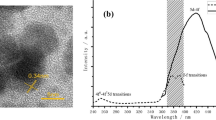Abstract
Eu3+ ions embedded in silica thin films co-doped with SnO2 nanocrystals were fabricated by sol–gel and spin-coating methods. SnO2 nanocrystals with controllable sizes were synthesized through precisely controlling the Sn concentrations. The influences of doping and annealing conditions on the photoluminescence intensity from SnO2 nanocrystals are systematically investigated. The effective energy transfer from the defect states of SnO2 nanocrystals to nearby Eu3+ ions has revealed by the selective photoluminescence excitation spectra. The efficiency of the Förster resonance energy transfer is evaluated by the time-resolved photoluminescence measurements, which is about 29.1 % based on the lifetime tests of the SnO2 emission.





Similar content being viewed by others
References
Wang HQ, Batentschuk M, Osvet A et al (2011) Rare-earth ions doped up-conversion materials for photovoltaic applications. Adv Mater 23:2675–2680
Wan N, Lin T, Xu J et al (2008) Preparation and luminescence of nano-sized In2O3 and rare-earth co-doped SiO2 thin films. Nanotechnology 19:095709–095714
Wang F, Deng RR, Wang J et al (2011) Tuning upconversion through energy migration in core-shell nanoparticles. Nat Mater 10:968–973
Li QB, Lin JM, Wu JH et al (2011) Preparation of Gd2O3: Eu3+ downconversion luminescent material and its application in dye-sensitized solar cells. Chin Sci Bull 56:3114–3118
Pal M, Pal U, Jimenez MGY et al (2012) Effects of crystallization and dopant concentration on the emission behavior of TiO2: Eu nanophosphors. Nanoscale Res Lett 7:1–12
Miniscalco MJ (1991) Erbium-doped glasses for fiber amplifiers at 1500 nm. J Lightwave Technol 9:234–251
Gu XQ, Zhu LP, Ye ZZ et al (2006) Fabrication and photoluminescence of Er-doped ZnO thin films on SiO2/Si substrate by pulse laser deposition. Rare Met 25:30–36
Zhou Z, Komori T, Yoshino M et al (2005) Enhanced 1.54 μm photoluminescence from Er-containing ZnO through nitrogen doping. Appl Phys Lett 86:041107–041109
Zhou Z, Komori T, Yoshino M et al (2005) Li and Er codoped ZnO with enhanced 1.54 μm photoemission. Appl Phys Lett 87:091109–091111
Yanes AC, Castillo JD, Torres M et al (2004) Nanocrystal-size selective spectroscopy in SnO2: Eu semiconductor quantum dots. Appl Phys Lett 85:2343–2345
Nogami M, Enomoto T, Hayakawa T et al (2002) Enhanced florescence of Eu3+ induced by energy transfer from nanosized SnO2 crystals in glass. J Lumin 97:147–152
Lin T, Ding XY, Xu J et al (2011) Influences of doping and annealing conditions on the photoluminescence from In2O3 nanocrystals and Eu3+ ions co-doped sol-gel SiO2 films. J Appl Phys 109:083512–083516
Fujii M, Yoshida M, Kanzawa Y et al (1997) 1.54 μm photoluminescence of Er doped into SiO2 films containing Si nanocrystals: Evidence for energy transfer from Si nanocrystals to Er. Appl Phys Lett 71:1198–1200
Kik PG, Dood MJA, Kikoin K et al (1997) Excitation and deexcitation of Er3+ in crystalline silicon. Appl Phys Lett 70:1721–1723
Priolo F, Franzo G, Coffa S et al (1998) Excitation and nonradiative deexcitation processes of Er3+ in crystalline Si. Phys Rev B 57:4443–4445
Lin T, Zhang XW, Wang YJ et al (2012) Luminescence enhancement due to energy transfer in ZnO nanoparticles and Eu3+ ions co-doped silica. Thin Solid Films 520:5815–5819
Yu YL, Chen DQ, Wang YS et al (2009) Enhanced photoluminescence of Eu3+ induced by energy transfer from In2O3 nano-crystals embedded in glassy matrix. Phys Chem Chem Phys 11:8774–8778
Wan N, Xu J, Lin T et al (2008) Energy transfer and enhanced luminescence in metal oxide nanoparticle and rare earth codoped silica. Appl Phys Lett 92:201109–201111
Li HB, Zhao H, Sheng Y et al (2012) Preparation, characterization and photo- luminescence properties of TiO2: Eu3+ nanorods and nanobelts. J Nanopart Res 14:947–956
Zhang KX, Yu YX, Sun SQ (2012) Influence of Eu doping on the microstructure and photoluminescence of CdS nanocrystals. Appl Surf Sci 258:7658–7663
Lin T, Wan N, Xu J et al (2010) Size-dependent optical properties of SnO2 nanoparticles prepared by soft chemical technique. J Nanosci Nanotechno 10:4357–4362
Shen RS, Li XP, Chuan XX et al (2012) Comparative investigation of three types of ethanol sensor based on NiO-SnO2 composite nanofibers. Chin Sci Bull 57:2087–2093
Zhang XW, Lin T, Xu J et al (2012) The luminescence enhancement of Eu3+ ions and SnO2 nanocrystals co-doped sol-gel SiO2 films. Chin Phys B 1:018101–018107
Biswas A, Maciel GS, Kapoor R et al (2003) Er3+-doped multicomponent sol-gel-processed silica glass for optical signal amplification at 1.5 μm. Appl Phys Lett 82:2389–2391
Buddhudu S, Morita M, Murakami S et al (1999) Temperature-dependent luminescence and energy transfer in europium and rare earth codoped nanostructured xerogel and sol-gel silica glasses. J Lumin 83:199–203
Bang J, Yang H, Holloway PH (2005) Enhanced luminescence of SiO2: Eu by energy transfer from ZnO nanoparticles. J Chem Phys 123:084709–084713
Yu YL, Chen DQ, Huang P et al (2011) Distribution-related luminescence of Eu3+ sensitized by SnO2 nano-crystals embedding in oxide glassy matrix. J Solid State Chem 184:236–240
Brovelli S, Chiodini A, Lauria A et al (2006) Energy transfer to erbium ions from wide-band-gap SnO2 nanocrystals in silica. Phys Rev B 73:074306
Brovelli S, Chiodini N, Lauria A et al (2006) Kinetics of luminescence of interface defects and resonant Er3+ ions in nanostructured SnO2: SiO2. Solid State Commun 138:574–576
Acknowledgments
This work was supported by the National Basic Research Program of China (2013CB632101) and the National Natural Science Foundation of China (11274155).
Author information
Authors and Affiliations
Corresponding author
Additional information
SPECIAL TOPIC: Wide Bandgap Semiconductor Materials and Devices
About this article
Cite this article
Zhang, X., Zhang, P., Lin, S. et al. Energy transfer process between Eu3+ and wide-band-gap SnO2 nanocrystals in silica films studied by photoluminescence excitation and time-resolved photoluminescence techniques. Chin. Sci. Bull. 59, 1285–1290 (2014). https://doi.org/10.1007/s11434-014-0168-y
Received:
Accepted:
Published:
Issue Date:
DOI: https://doi.org/10.1007/s11434-014-0168-y




